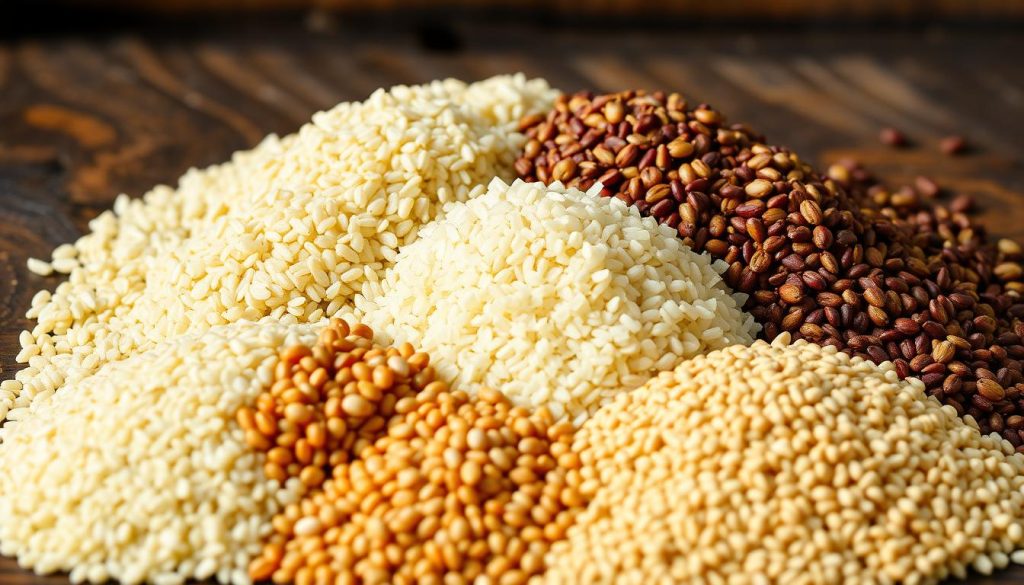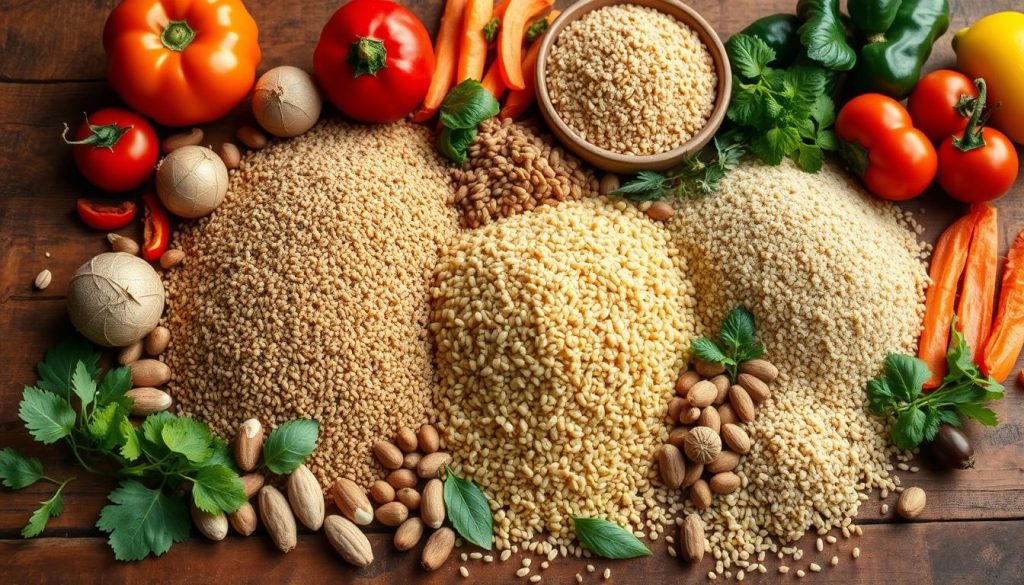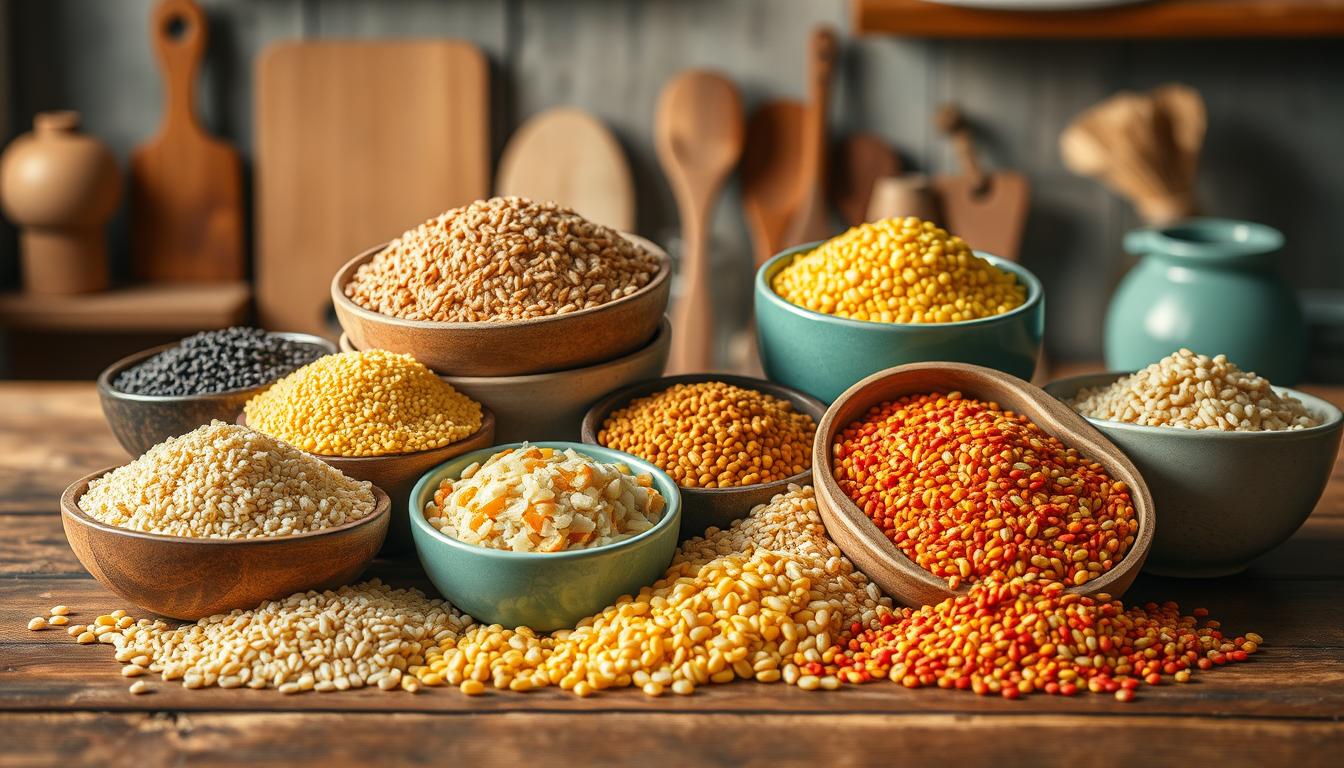Are you looking to add variety to your cooking without losing flavor or nutrition? This millet substitute guide is for you. It’s perfect whether you’re new to millet or need substitutes for your favorite dishes. Learning about different options can expand your cooking horizons.
Millet is loved for its light texture and subtle nutty taste. It’s a favorite in many cuisines. But sometimes, you might need alternatives due to dietary needs or availability. Luckily, there are several gluten-free grains that can take millet’s place. This guide will help you find the best substitutes for your next dish.
Understanding Millet and Its Uses
Millet is known for its nutritional value and versatility in cooking. It’s a gluten-free grain that’s often overlooked but is very healthy. Let’s explore its uses in cooking and its health benefits.
What is Millet?
Millet is a group of small-seeded grains that are very nutritious. It’s a staple in Africa and Asia. With over 20 types, millet is rich in proteins, fiber, and minerals like magnesium, iron, and calcium.
It’s easy to digest and has many health benefits. Millet can help with digestion, heart health, and even lower heart disease risk. It also has antioxidants that fight chronic diseases.
Culinary Applications of Millet
Cooking with millet offers many options for different tastes and diets. You can boil, toast, or grind it into flour. Millet can be used in many dishes, such as:
- Porridge
- Breads
- Salads
- Soups
- Stuffed vegetables
- Muffins and pancakes
To make millet fluffy, use 2 parts water to 1 part millet. For a creamier porridge, use 3 parts water to 1 part millet. Adding millet to your meals can make them tastier and healthier.
| Millet Variety | Key Nutritional Benefits | Common Culinary Uses |
|---|---|---|
| Pearl Millet | Rich in protein and fiber | Grains, breads, and porridge |
| Finger Millet (Ragi) | High in calcium and iron | Flour for baked goods and porridge |
| Foxtail Millet | Contains B-vitamins and antioxidants | Salads, pilafs, and snacks |
| Kodo Millet | Supports weight management | Soups, stews, and pilafs |
| Sorghum Millet | Helps with cholesterol reduction | Baking, porridge, and gruels |
Identifying Suitable Millet Substitutes
Finding the right millet substitute requires careful thought. Look at flavor, texture, and cooking time. These factors greatly affect your dish’s taste and feel. Here are key points to keep in mind when picking a millet substitute.
Key Factors to Consider When Choosing a Substitute
When searching for millet alternatives, remember these important points:
- Texture: Make sure the substitute has a similar texture to millet. This is crucial for grain bowls or baked goods.
- Flavor: Choose grains with a flavor that matches millet. This keeps your dish’s taste true.
- Cooking Time: Note how long each substitute takes to cook. This affects your meal prep time.
- Application: Decide if you need a whole grain or flour substitute. This depends on your recipe.
Gluten-Free Options
For those looking for gluten-free grains, many options work as millet substitutes. Quinoa, amaranth, and sorghum are great choices. They have good nutrition and cook like millet. Here’s a quick look at these grains:
| Grain | Water Ratio | Cooking Time | Protein Content |
|---|---|---|---|
| Quinoa | 2:1 | 15 minutes | High |
| Sorghum | 3:1 | 50-60 minutes | Moderate |
| Amaranth | 3:1 | 20 minutes | Moderate to High |
These gluten-free grains not only replace millet but also taste and feel similar. Trying these substitutes opens up new cooking possibilities. It helps you stick to your dietary needs while enjoying different flavors.
Top Millet Substitute Guide
Finding the right millet substitute can make your dishes better. It keeps the flavor and nutrients. Here are some top substitutes for millet that you can add to your meals.
Quinoa as a Millet Alternative
Quinoa is a great quinoa alternative. It has lots of protein and a fluffy texture. It cooks quickly, which is perfect for fast meals.
Use it in salads or bowls. Quinoa is as versatile as millet.
Amaranth: A Nutty Replacement
Amaranth is packed with nutrients and has a unique flavor. It looks like millet and tastes nutty. Enjoy it in porridge or as a side dish.
Its distinct taste is a highlight in many recipes.
Brown Rice: Versatile and Accessible
Brown rice is a good millet substitute. It has a light, fluffy texture like millet. It’s easy to use in recipes.
While it’s chewier, brown rice is reliable. Pair it with veggies, proteins, or sauces for a tasty meal.
Sorghum: A Sweet and Hearty Option
Sorghum is sweet and hearty. It’s great in both savory and sweet dishes. Its unique taste makes it shine in salads, soups, and baked goods.
Grain-Based Substitutes for Millet
Looking for grain-based substitutes for millet? Several options offer unique textures and flavors. Each alternative brings its own benefits to dishes, making them great for many recipes. Here are three notable substitutes.
Bulgur: A Chewy Alternative
Bulgur is a whole grain made from cracked wheat that cooks fast. It’s perfect for salads, grain bowls, or as a side dish. It’s rich in fiber, supporting digestive health, and packed with vitamins and minerals for a balanced diet.
Barley: When Chewiness Is Desired
Barley is known for its chewy texture, enhancing soups and stews. It adds depth and soaks up flavors well. Used in barley in cooking, it boosts heartiness and is full of beta-glucans, a fiber that’s good for the heart and blood sugar.
Farro: Rustic and Flavorful
Farro has a rich, nutty flavor and a hearty texture. It’s great in salads and grain bowls. It’s high in protein, fiber, and micronutrients like magnesium and iron. Adding farro to your diet supports wellness and makes dishes satisfying.

Millet Flour Alternatives for Baking
Exploring alternatives to millet flour in baking can be exciting. It keeps your baked goods gluten-free. Knowing the traits of each substitute helps get the right texture and taste. Here are some top millet flour substitutes and tips for adjusting your recipes.
Best Substitutes for Millet Flour
- Sorghum Flour: It’s often used like millet flour. It has a mild, sweet taste and a smooth texture.
- Buckwheat Flour: It’s gluten-free and has a unique earthy flavor.
- Teff Flour: Nutrient-rich, it adds a nutty taste and works well in dense baked goods.
- Brown Rice Flour: A common gluten-free choice, it adds a nutty flavor and blends well with other flours.
- Coconut Flour: It absorbs a lot of liquid. Use 1/4 to 1/3 cup for every 1 cup of all-purpose flour. Add more eggs for better texture.
- Spelt Flour: Not gluten-free, but can be used like all-purpose flour for a wholesome taste.
How to Adjust Recipes When Substituting Flours
When substituting millet flour, some adjustments are key for gluten-free baking. Here are some tips:
- For sorghum and millet flour, use them 1:1 in most recipes.
- Coconut flour needs more liquid. Adjust liquid amounts to avoid dryness.
- Use tapioca flour for thickening, as it’s fiber- and protein-free.
- Keep millet flour to 15-20% to avoid a dense texture in bread or muffins.
Trying out these millet flour substitutes can make baking more fun. Whether making muffins, bread, or other treats, these alternatives let you create unique flavors while sticking to a gluten-free diet.
Health Benefits of Millet Substitutes
Exploring the health perks of millet alternatives in your diet is key. Knowing the nutritional differences among these grains is crucial. Each substitute offers unique tastes and a wealth of nutrients good for your health. By comparing these profiles, you can choose better options for your meals.
Nutritional Profiles Compared
Grains like quinoa and amaranth are nutritional powerhouses. Quinoa is high in protein, while amaranth is rich in fiber and vitamins. This comparison highlights various healthy choices:
| Substitute | Calories (per Cup) | Protein | Fiber | Key Nutrients |
|---|---|---|---|---|
| Quinoa | 222 | 8 grams | 5 grams | Magnesium, Iron |
| Amaranth | 251 | 9 grams | 5 grams | Calcium, Vitamin B6 |
| Little Millet | 207 | 7.7 grams | 9.8 grams | Calcium, Iron, Magnesium |
| Finger Millet | 300 | 7 grams | 6 grams | Calcium, Antioxidants |
Potential Health Benefits of Each Substitute
There are many benefits to using millet alternatives. Quinoa supports muscle growth with its protein. Amaranth boosts digestive health with its fiber. Millets are low on the glycemic index, good for diabetes management.
Finger millet is rich in calcium, supporting bone health. Its antioxidants may lower disease risks. Little millet helps with energy and weight control. Adding these substitutes to your meals can boost your health.

Culinary Considerations When Substituting Millet
When looking for millet substitutes, it’s key to know the unique tastes of each grain. This knowledge helps pick the right substitute for your recipes. It makes sure the dish tastes as you want it to.
Flavor Profiles to Note
Every grain has its own taste, changing how your dishes taste. Quinoa has a *nutty flavor*, great for salads and grain bowls. Buckwheat, on the other hand, has an *earthy bitterness*, perfect for pancakes and baked goods. Knowing these flavors helps match grains to recipes, making dishes taste better.
Cooking Methods for Different Grains
Cooking methods for grains differ, affecting texture and taste. Quinoa needs rinsing and a 2:1 water ratio. Barley cooks longer, making it chewier and good for hearty dishes. Farro cooks longer too, but adds a hearty, nutty taste to grain salads. Learning how to cook these grains right makes your dishes better and brings out the flavors.
Conclusion
This guide has shown you how to use millet and its substitutes. You’ve learned about quinoa, amaranth, and other grains. This knowledge helps you make healthy and varied meals.
2023 is the year of millets, as declared by the United Nations and India’s government. Adding these grains to your diet can boost your health. They support weight loss, heart health, and digestion.
Using millet substitutes makes cooking more fun and sustainable. With the right tips, you can make healthy choices. Be bold in your kitchen and see how great these grains taste!
Source Links
- https://lowhistamineeats.com/substitute-for-millet-flour/
- https://www.bbcgoodfood.com/health/special-diets/best-flour-substitutions
- https://www.finedininglovers.com/explore/articles/10-different-types-millet-and-how-use-them
- https://www.medicalnewstoday.com/articles/what-is-millet
- https://www.webmd.com/diet/health-benefits-millet
- https://discover.texasrealfood.com/swap-and-savor/millet-substitutes
- https://gustomeadow.com/millet-flour-substitutes/
- https://www.bmc.org/nourishing-our-community/teaching-kitchen/substitution-guide
- https://www.simplyrecipes.com/the_ultimate_guide_to_flour_how_to_swap_substitute_and_supplement_your_favorite_flours/
- https://zestforbaking.com/the-top-substitutes-for-millet-flour
- https://cucinanicolina.com/guide-to-gluten-free-flours/
- https://gluten.org/2019/10/17/gluten-free-grains/
- https://arrowheadmills.com/blog/a-guide-to-arrowhead-mills-flours/
- https://everydayglutenfreegourmet.ca/use-millet-flour-sorghum-flour/
- https://www.healthline.com/nutrition/what-is-millet
- https://pmc.ncbi.nlm.nih.gov/articles/PMC8005370/
- https://www.milletmaagicmeal.in/blogs/blogs/little-millet-health-benefits?srsltid=AfmBOorTboL_1EciWQKUUAfCU41tatLM80SO0Lanik8cFt7zfQLdlAZk
- https://casadesante.com/blogs/flour-guide/millet-flour-vs-all-purpose-flour?srsltid=AfmBOopsmTx-47hUt2s_p3ubw5yHFIbpJtdQAhNtw2nEJhR5OUou-16r
- https://craftycookery.net/substitution-charts/
- https://twobrothersindiashop.com/blogs/food-health/millets-vs-quinoa?srsltid=AfmBOoq3WzGeRKrYqTwZGWjkXPJUslFAwi_Xjbj07IgDmghWn4WYN-wF
- https://casadesante.com/blogs/flour-guide/millet-flour-vs-all-purpose-flour?srsltid=AfmBOor1Lqzq6KbPGNmAWHaykHJeKDmJcw7TNtvLK9pPch-RHOdg5V4t
